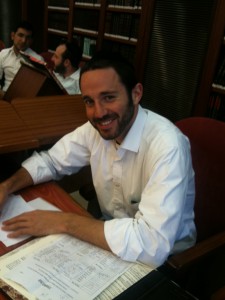 Rosh Hashanah (Hebrew: ראש השנה) is the name of a text of Jewish law originating in the Mishnah which formed the basis of tractates in both the Babylonian Talmud and the Jerusalem Talmud of the same name. It is the eighth tractate of the order Moed. The text contains the most important rules concerning the calendar year, together with a description of the inauguration of the months, laws on the form and use of the shofar and laws related to the religious services during the Jewish holiday of Rosh Hashanah.
Rosh Hashanah (Hebrew: ראש השנה) is the name of a text of Jewish law originating in the Mishnah which formed the basis of tractates in both the Babylonian Talmud and the Jerusalem Talmud of the same name. It is the eighth tractate of the order Moed. The text contains the most important rules concerning the calendar year, together with a description of the inauguration of the months, laws on the form and use of the shofar and laws related to the religious services during the Jewish holiday of Rosh Hashanah.The Mishnah commences with an account of the four beginnings of the religious and the civil year (1:1); it speaks of the four judgement-days of the pilgrim festivals and Rosh ha-Shanah (1:2); of the six months in which the messengers of the Sanhedrin announce the month (1:3); of the two months, the beginnings of which witnesses announce to the Sanhedrin even on the Sabbath (1:4), and even if the moon is visible to every one (1:5); Gamliel even sent on the Sabbath for forty pairs of witnesses from a distance (1:6); when father and son (who as relatives may otherwise not witness together) behold the new moon they must set out for the beth din (1:7), since they do not absolutely belong to those that are legally unfit for this purpose (1:8).
The weak and sick are borne on litters, and are protected against the attacks of the Sadducees; they must be provided with food, for witnesses were bound to journey even on the Sabbath (1:9). Others went along to identify the unknown (2:1). In olden times bonfire-signals on the mountains announced to all as far as Babylon that the month had been sanctified. The custom of having witnesses and messengers was introduced after the Sadducees had attempted to practice deception (2:2, 2:3, 2:4). The large court called Bet Ya’azeḳ was the assembly-place for the witnesses (2:5); bountiful repasts awaited them, and dispensations from the Law were granted to them (2:6); the first pair of witnesses was questioned separately concerning the appearance of the moon, but all other witnesses were questioned at least cursorily. The Mishnah makes the point that all witnesses must be made to feel their testimony is valued to ensure witnesses continue to come to courts (2:6). Then the av bet din (head of the Court) called out to a large assembly, “Sanctified!” all the people cried out aloud after him (2:8). Gamliel II had representations of the moon which he showed to the witnesses. There once arose a dispute between him and Joshua regarding the Tishri moon; the latter, in obedience to the nasi, came on foot to Jamnia on the day which he had calculated to be the Day of Atonement, and the two scholars made peace (iii.). There were various obstacles to the sanctification of the months, as when time was lacking for the ceremony, or when there were no witnesses present before the bet din. In the first case the following day became the new moon; in the second case the bet din alone performed the sanctification.
The Mishnah treats also the laws of the shofar (iii.2); the horn of the cow may not be used (iii.2); the form of the trumpet for Rosh ha-Shanah, the fast-day, and Yobel is determined (iii.3-5); injuries to the shofar and the remedies are indicated (iii.6); in times of danger the people that pray assemble in pits and caves (iii.7); they pass the house of worship only on the outside while the trumpets sound (iii.7); they are exhorted to be firm by being reminded of Moses‘ uplifted hands in the war with the Amalekites (iii.8). In such times the deaf-mutes, insane, and children are legally unfit for blowing the trumpets. Johanan ben Zakkai established that the shofar trumpets be blown at Jamnia and the surrounding places even if the festival fell on the Sabbath, while at one time this was done only in the Temple (iv.1); he also fixed the lulav outside of the Temple for seven days, and forbade the eating of new grain on the second day of Passover (iv.2); he extended the time for examining witnesses until the evening, and had them come to Jamnia even in the absence of the av bet din (iv.3). The Mishnah then treats of the order of the prayers (iv.4), of the succession of the Malkuyot, Zikronot, and Shoferot, of the Bible sentences concerning the kingdom of God, Providence, and the trumpet-call of the future (iv.5), and of the leader in prayer and his relation to the teki’ah (iv.6); descriptions of the festival are given in reference to the shofar (iv.7); then follows the order of the traditional trumpet-sounds (iv.8); and remarks on the duties of the leader in prayer and of the congregation close the treatise (iv.9).
To read the text clic here:
